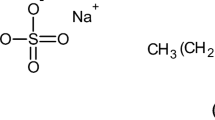Abstract
Mixed micellization behavior of dimeric cationic surfactants ethanediyl-1,2-bis(dimethyl alkyl ammonium bromide) (m-2-m where m = 10, 12) with conventional single chain cationic surfactants like cetyltrimethyl ammonium bromide (CTAB), cetylpyridinium chloride (CPC), tetradecyl dimethyl benzyl ammonium chloride (C14BCl) and cetyl dimethyl benzyl ammonium chloride (C16BCl) were studied in aqueous and aqueous polyethylene glycol (PEG) solutions at 298.15, 308.15 and 318.15 K respectively using conductometric and viscometric methods. In aqueous solutions, all the combinations (except 12-2-12 + CTAB) were found to behave nonideally with mutual synergism which decreases with increase in temperature. Various thermodynamic parameters of micellization like \( {{\Updelta}}G_{\text{m}}^{\text{o}} \), \( {{\Updelta}}H_{\text{m}}^{\text{o}} \) and \( {{\Updelta}}S_{\text{m}}^{\text{o}} \) were evaluated and discussed. Similarly in presence of PEG, the thermodynamic properties like \( {{\Updelta}}G_{\text{t}}^{\text{o}} \), \( {{\Updelta}}H_{\text{t}}^{\text{o}} \) and \( {{\Updelta}}S_{\text{t}}^{\text{o}} \) associated with the transfer of surfactant monomers from the medium consisting of polymer-free mixed micelles to polymer-bound mixed micelles at various temperatures were also calculated. The negative values of \( {{\Updelta}}H_{\text{t}}^{\text{o}} \) show that aggregation process is more exothermic than micellization whereas the negative values of \( {{\Updelta}}S_{\text{t}}^{\text{o}} \) indicate that the presence of polymer bound mixed micelles decreases the degree of randomness of the system. Viscosity studies show that in aqueous solutions all the combinations of 10-2-10/12-2-12 display negative departure in the relative viscosity (ηr) from additivity rule which decreases with increase in temperature. Similarly in the presence of 5% PEG solutions the magnitude of the negative departure decreases for all the combinations and becomes positive in the case of C14BCl and CPC combinations with the studied gemini surfactants at higher temperatures.





Similar content being viewed by others
References
Scamehorn JF (1986) Phenomena in mixed surfactant systems. In: Scamehorn JF (ed) ACS symposium series 311. American Chemical Society, Washington
Hill RM (1993) Mixed surfactant systems. In: Ogino K, Abe M (eds) Surfactant science series 46. Marcel Dekker, New York
Goddard ED, Ananthapadmanabhan KP (1993) Interactions of surfactants with polymers and proteins. CRC Press, Boca Raton
Shinoda K, Nakagawa T, Tamamushi B, Isemura T (1963) Colloidal surfactants. Academic, New York
Jonsson B, Lindman B, Holmberg K, Kronberg B (1998) Surfactants and polymers in aqueous solutions. Wiley, New York
Din Kabir-ud, Sheikh MS, Dar AA (2010) Analysis of mixed micellar and interfacial behavior of cationic gemini hexanediyl-1,6-bis(dimethylcetylammonium bromide) with conventional ionic and nonionic surfactants in aqueous medium. J Phys Chem B 114:6023–6032
Lange H (1953) Über Die Mizellenbildung in Mischlösungen homologer Paraffinkettensalze. Kolloid Z 131:96–103
Clint JH (1975) Micellization of mixed nonionic surface active agents. J Chem Soc Faraday Trans 71:1327–1334
Rubingh DN (1979) Mixed micelle solutions. In: Mittal KL (ed) Solution chemistry of surfactants, vol 1. Plenum, New York, p 337
Rosen MJ, Hua XY (1982) Surface concentrations and molecular interactions in binary mixtures of surfactants. J Colloid Interface Sci 86:164–172
Maeda H (1995) A simple thermodynamic analysis of the stability of ionic/non-ionic mixed micelles of surfactants. J Colloid Interface Sci 172:98–105
Motomura K, Aratono M (1993) Mixed surfactant systems. In: Ogino K, Abe M (eds) Surfactant science series 46. Marcel Dekker, New York
Blankschtein D, Puvvada S, Sarmoria C (1992) Prediction of critical micelle concentrations of nonideal binary surfactant mixtures. Langmuir 8:2690–2697
Ali MS, Suhail M, Ghosh G, Kamil M, Kabir-ud-Din (2009) Interactions between cationic gemini/conventional surfactants with polyvinylpyrrolidone: specific conductivity and dynamic light scattering studies. Colloids Surf A 350:51–56
Zana R, Lévy H (1997) Alkanediyl-α,ω-bis(dimethylalkylammonium bromide) surfactants (dimeric surfactants) part 6. CMC of the ethanediyl-1,2-bis(dimethylalkylammonium bromide) series. Colloids Surf A 127:229–232
Bakshi MS, Sharma P, Kaur G, Sachar S, Banipal TS (2006) Synergistic mixing of L64 with various surfactants of identical hydrophobicity under the effect of temperature. Colloids Surf A 278:218–228
Sood AK, Singh K, Banipal TS (2010) Study of micellization behavior of some alkyldimethylbenzyl ammonium chloride surfactants in presence of polymers. J Dispersion Sci Technol 30:62–71
Bakshi MS, Singh J, Singh K, Kaur G (2004) Mixed micelles of cationic 12–2–12 gemini with conventional surfactants: the head group and counterion effects. Colloids Surf A 237:61–71
Banipal TS, Sood AK, Singh K (2011) Micellization behavior of the 14–2–14 gemini surfactant with some conventional surfactants at different temperatures. J Surf Deterg 14:235–244
Bakshi MS, Singh K (2005) Synergistic interactions in the mixed micelles of cationic gemini with zwitterionic surfactants: fluorescence and Kraft temperature studies. J Colloid Interface Sci 287:288–297
Kabir-ud-Din, Sheikh MS, Dar AA (2009) Interaction of a cationic gemini surfactant with conventional surfactants in the mixed micelle and monolayer formation in aqueous medium. J Colloid Interface Sci 333:605–612
Ali MS, Suhail M, Ghosh G, Kamil M, Kabir-ud-Din (2009) Interactions between cationic gemini/conventional surfactants with polyvinylpyrrolidone: specific conductivity and dynamic light scattering studies. Colloids Surf A 350:51–56
Mehta SK, Chaudhary S, Bhasin KK (2009) Spectral characterization and colloidal properties of 1-hexadecylpyridinium chloride in aqueous binary mixtures of different glycols. J Colloid Interface Sci 333:646–654
Anthony O, Zana R (1994) Effect of temperature on the interactions between neutral polymers and a cationic and a nonionic surfactant in aqueous solutions. Langmuir 10:4048–4052
Bakshi MS, Bhandari P, Sachar S, Mahajan RK (2006) Mixed micelles of binary triblock polymer mixture in pure water at 30 °C. Colloid Polymer Sci 284:1363–1370
Akbaş H, Elemenli A, Boz M (2011) Aggregation and thermodynamic properties of some cationic gemini surfactants. J Surf Deterg. doi:10.1007/s11743-011-1270-7 (Published online 20 April 2011)
Batıgöç Ç, Akbaş H, Boz M (2011) Micellization behavior and thermodynamic parameters of 12–2–12 gemini surfactant in (water + organic solvent) mixtures. J Chem Thermodynamics 43:1349–1354
Author information
Authors and Affiliations
Corresponding author
Electronic supplementary material
Below is the link to the electronic supplementary material.
About this article
Cite this article
Sood, A.K., Singh, K., Kaur, J. et al. Mixed Micellization Behavior of m-2-m Gemini Surfactants with Some Conventional Surfactants at Different Temperatures. J Surfact Deterg 15, 327–338 (2012). https://doi.org/10.1007/s11743-011-1314-z
Received:
Accepted:
Published:
Issue Date:
DOI: https://doi.org/10.1007/s11743-011-1314-z




